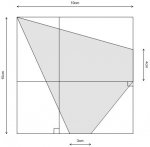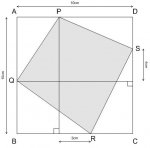You are using an out of date browser. It may not display this or other websites correctly.
You should upgrade or use an alternative browser.
You should upgrade or use an alternative browser.
Please find the perimeter of the shaded area
- Thread starter loch2003
- Start date
loch2003 said:Thahks for your reply, but how to find the triangle's area?
\(\displaystyle \text{I can assure you that he are of the square is 100cm^2 }\) :wink:
About the white triangles: they are all perpendicular.
The attach is a square with length of 10cm, please find the perimeter of the shaded area.
Hello, Loch2003,
There appears to be some information missing from your problem statement or picture. Please review them carefully and supply the missing information.
If the segment lengths along the edges of the square can be determined, then the hypotenuse of each right triangle can be determined.
Hope that helps.
Hello, loch2003!
On the bottom, let the left segment be \(\displaystyle x.\)
. . Then the right segment is \(\displaystyle 7-x\)
On the right side, let the bottom segment be \(\displaystyle y.\)
. . Then the top segment is \(\displaystyle 6-y\)
The perimeter of the region is comprised of the hypotenuses
. . of the three right triangles, plus 3 and 4.
Hence: .\(\displaystyle P \;=\;\sqrt{x^2+10^2} + \sqrt{(6-y)^2 + 10^2} + \sqrt{(7-x)^2+y^2} + 7\)
Without more information, there is no unique answer.
On the bottom, let the left segment be \(\displaystyle x.\)
. . Then the right segment is \(\displaystyle 7-x\)
On the right side, let the bottom segment be \(\displaystyle y.\)
. . Then the top segment is \(\displaystyle 6-y\)
The perimeter of the region is comprised of the hypotenuses
. . of the three right triangles, plus 3 and 4.
Hence: .\(\displaystyle P \;=\;\sqrt{x^2+10^2} + \sqrt{(6-y)^2 + 10^2} + \sqrt{(7-x)^2+y^2} + 7\)
Without more information, there is no unique answer.
loch2003 said:Sorry to everybody, the drawing is wrong. Please find the correct one.
You still have not given us any more information than you posted before...and with what I see from BOTH of your postings, there is still some vital information missing.
You can get both diagonals of the quadrilateral:
PR = sqrt(10^2 + 3^2) = sqrt(109)
QS = sqrt(10^2 + 4^2) = sqrt(116)
However, nothing seems to prevent point S from coinciding with point D, and point R with point C.
So, re-naming the square ABRS, then quadrilateral has sides PS = 3, RS = 10 and:
QP^2 = AP^2 + AQ^2 = 7^2 + 4^2 = 65; QP = sqrt(65)
QR^2 = BR^2 + BQ^2 = 10^2 + 6^2 = 136; QR = sqrt(136)
Perimeter of quadrilateral PQRS = 13 + sqrt(65) + sqrt(136)
Well, any attempt is better than none!
EDIT:
had another look at above idea: results in same area for the quadrilaterals,
but not same perimeter.
C'mon Loch, we need MORE INFO :shock:
In case interested; smallest case where the quad's sides are all integers and different:
square sides = 108
triangle APQ: 60-63-87
triangle BRQ: 48-90-102
triangle CRS: 18-80-82
triangle DPS: 28-45-53
Last numbers (87,102,82,53) are the quad's sides.
PR = sqrt(10^2 + 3^2) = sqrt(109)
QS = sqrt(10^2 + 4^2) = sqrt(116)
However, nothing seems to prevent point S from coinciding with point D, and point R with point C.
So, re-naming the square ABRS, then quadrilateral has sides PS = 3, RS = 10 and:
QP^2 = AP^2 + AQ^2 = 7^2 + 4^2 = 65; QP = sqrt(65)
QR^2 = BR^2 + BQ^2 = 10^2 + 6^2 = 136; QR = sqrt(136)
Perimeter of quadrilateral PQRS = 13 + sqrt(65) + sqrt(136)
Well, any attempt is better than none!
EDIT:
had another look at above idea: results in same area for the quadrilaterals,
but not same perimeter.
C'mon Loch, we need MORE INFO :shock:
In case interested; smallest case where the quad's sides are all integers and different:
square sides = 108
triangle APQ: 60-63-87
triangle BRQ: 48-90-102
triangle CRS: 18-80-82
triangle DPS: 28-45-53
Last numbers (87,102,82,53) are the quad's sides.
mmm4444bot
Super Moderator
- Joined
- Oct 6, 2005
- Messages
- 10,902
Both of the line segments labeled 4 cm and 3 cm are the same length, in this diagram.
Too bad the horizontal and vertical scales are not consistent, in this diagram; otherwise, we could have found the perimeter by measuring it.


